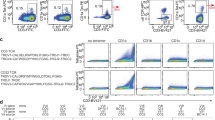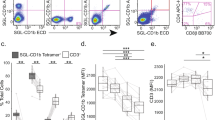Abstract
The T-cell receptor (TCR) γ polypeptide is expressed associated with CD3(T3) on the surface of normal human peripheral blood lymphocytes. These cells function as non-MHC-restricted cytotoxic T lymphocytes (CTL) and thus may play an important role in host immune defence. The TCR γ polypeptide occurs as a dimer in at least two molecular forms based on the absence or presence of disulphide linkage. These forms use TCR γ polypeptides with strikingly different peptide backbone sizes.
This is a preview of subscription content, access via your institution
Access options
Subscribe to this journal
Receive 51 print issues and online access
$199.00 per year
only $3.90 per issue
Buy this article
- Purchase on Springer Link
- Instant access to full article PDF
Prices may be subject to local taxes which are calculated during checkout
Similar content being viewed by others
References
Saito, H. et al. Nature 309, 757–762 (1984).
Kranz, D. M. et al. Nature 313, 752–755 (1985).
Hayday, A. C. et al. Cell 40, 259–269 (1985).
Lefranc, M-P. & Rabbitts, T. H. Nature 316, 464–466 (1985).
Murre, C. et al. Nature 316, 549–552 (1985).
Brenner, M. B. et al. Nature 322, 145–149 (1986).
Bank, I. et al. Nature 322, 179–181 (1986).
Raulet, D. H., Garman, R. D., Saito, H. & Tonegawa, S. Nature 314, 103–107 (1985).
Snodgrass, H. R., Dembic, Z., Steinmetz, M. & von Boehmer, H. Nature 315, 232–233 (1985).
Weiss, A., Newton, M. & Crommie, D. Proc. natn. Acad. Sci. U.S.A. 83, 6998–7002 (1986).
Lanier, L. L. & Weiss, A. Nature 324, 268–270 (1986).
Brenner, M. B. et al. J. lmmun. (in the press).
Quertermous, T., Strauss, W. M., van Dongen, J. M. & Seidman, J. G. J. lmmun. (in the press).
Quertermous, T. et al. Science 231, 252–255 (1986).
Duby, A. D. & Seidman, J. G. Proc. natn. Acad. Sci. U.S.A. 83, 4890–4894 (1986).
Brenner, M. B. et al. J. lmmun. 135, 384–390 (1985).
De la Hera, A., Toribio, M. L., Marquez, C. & Martinez-A., C. Proc. natn. Acad. Sci. U.S.A. 82, 6268–6271 (1985).
Nowill, A. et al. J. exp. Med. 163, 1601–1606 (1986).
Lanier, L. L., Ruitenberg, J. J. & Phillips, J. H. J. exp. Med. 164, 339–344 (1986).
Moingeon, P. et al. Nature 323, 638–640 (1986).
Beverley, P. C. & Callard, R. E. Eur. J. Immun. 11, 329–334 (1981).
Brenner, M. B., Trowbridge, I. S., McLean, J. & Strominger, J. L. J. exp. Med. 160, 541–551 (1984).
Samelson, L. E., Harford, J., Schwartz, R. H. & Klausner, R. D. Proc. natn. Acad. Sci. U.S.A. 82, 1969–1973 (1985).
Brenner, M. B., Trowbridge, I. S. & Strominger, J. L. Cell 40, 183–190 (1985).
Yelton, D. E., Desaymard, C. & Scharff, M. D. Hybridoma 1, 5–11 (1981).
Dialynas, D. P. et al. Proc natn. Acad. Sci. U.S.A. 83, 2619–2623 (1986).
Yanagi, Y., Yoshikai, Y., Leggett, K., Clark, S. P., Aleksander, I. & Mak, T. W. Nature 308, 145–149 (1984).
Krangel, M. S., Orr, H. T. & Strominger, J. L. Cell 18, 979–991 (1979).
Bonner, W. J. & Laskey, R. A. Eur. J. Biochem. 46, 83–88 (1974).
Wigler, M. et al. Cell 16, 777–785 (1979).
Southern, E. M. J. molec. Biol. 98, 503–517 (1975).
Barnstable, C. J. et al. Cell 14, 9–20 (1978).
Bushkin, Y., Posnett, D. N., Pernis, B. & Wang, C. Y. J. exp. Med. 164, 458–473 (1986).
Yang, S. Y. et al. Immunogenetics 19, 217–231 (1984).
Spear, B. T., Kornbluth, J., Strominger, J. L. & Wilson, D. B. J. exp. Med. 162, 1802–1810 (1985).
Gorga, J. C., Foran, J., Burakoff, S. J. & Strominger, J. L. Meth. Enzym. 108, 607–613 (1984).
Chen, Y. X. et al. Hum. lmmun. 10, 221–235 (1984).
Krangel, M. S. et al. Proc. natn. Acad. Sci. (in the press).
Author information
Authors and Affiliations
Rights and permissions
About this article
Cite this article
Brenner, M., McLean, J., Scheft, H. et al. Two forms of the T-cell receptor γ protein found on peripheral blood cytotoxic T lymphocytes. Nature 325, 689–694 (1987). https://doi.org/10.1038/325689a0
Received:
Accepted:
Issue Date:
DOI: https://doi.org/10.1038/325689a0
This article is cited by
-
γδ T Lymphocytes—Selectable Cells Within the Innate System?
Journal of Clinical Immunology (2007)
-
Individual Vγ2-Jγ1.2+ T cells respond to both isopentenyl pyrophosphate and Daudi cell stimulation: generating tumor effectors with low molecular weight phosphoantigens
Cancer Immunology, Immunotherapy (2007)
-
Induction of αδ- and αβ-mediated T cell responses in healthy elderly subjects after influenza vaccination
Biogerontology (2006)
-
Circulating γδ T cells in young/adult and old patients with cutaneous primary melanoma
Immunity & Ageing (2005)
-
A role for epithelial γδ T cells in tissue repair
Springer Seminars in Immunopathology (2000)
Comments
By submitting a comment you agree to abide by our Terms and Community Guidelines. If you find something abusive or that does not comply with our terms or guidelines please flag it as inappropriate.



